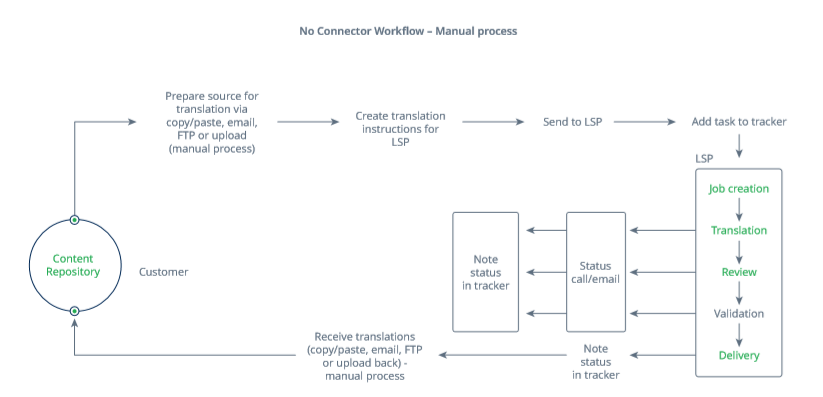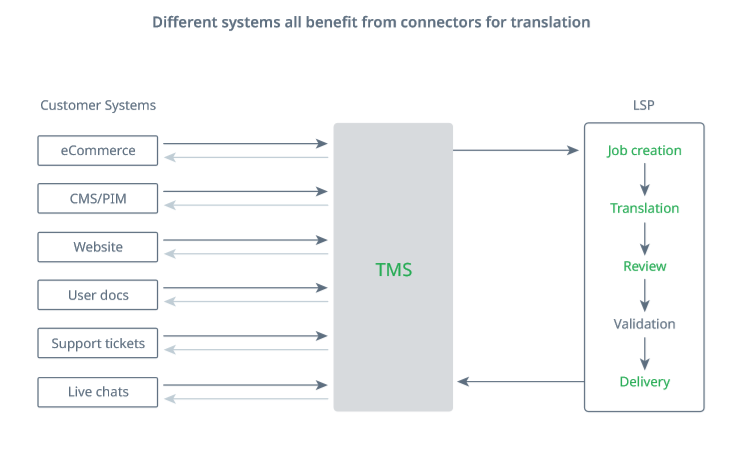With global B2C ecommerce sales expected to reach $4.5 trillion by 2021, it’s no wonder that companies are increasing their content creation budgets by an average of 56% (over the past 12 months) to attract and retain global customers. Efficiency, cost-effectiveness and automation are critical to keep up with this never-ending demand for translated content. To support this herculean effort, companies require a variety of technologies, including translation technology, to create and deliver content globally.
Operating with disconnected or legacy systems—or both—makes handing content off to translation manual and time-consuming, impacting time to market and customer satisfaction. However, linking content systems with connectors and integrations jump starts the content translation process, making it agile, streamlined and effective.
What is a connector? And why do I need one?
Connectors are designed to reduce manual tasks and improve productivity. Without connectors, content must be extracted manually from where it was authored and managed, typically a Content Management System (CMS), Product Information System (PIM) or content repository, and provided to the Language Service Provider (LSP).
Methods to extract and prepare content for translation can vary and can include manually copy/pasting, emailing or uploading to FTP or vendor-specific tools. Once the content is sent, instructions need to be created and the task tracked and managed. Then, just when everything is handed off, the process is reversed to get the translated content back into the original system. Compounding the hassle, these manual steps introduce a high risk of human error, waste valuable work time and require many tools and UIs. The diagram below highlights the many steps required in a workflow without connectors.

Connectors connect separate systems to automate workflows, control the process, reduce risk and free users up for more important tasks. Embedded in third-party tools or integrated out of the box with the customer portal, connectors in translation management systems (TMS) like
SDL Language Cloud enable users to quickly and easily select content from the CMS and create a translation job. With just a few clicks, the translation job is passed to the TMS and all content is translated and managed within the system. When the translation is complete, the files are passed back to the CMS, skipping the tiresome upload/download or copy/paste process. The diagram below shows the efficiencies gained with connectors.
The future of connectors
Increasingly, due to acquisitions and past purchasing decisions, companies are finding they need more and more connectors to link their multiple systems. Other companies find consolidating onto one platform is more efficient while lowering maintenance and subscription fees.
Market consolidation is also changing the landscape for connectors. Companies like Adobe who possess a suite of products—Adobe Experience Manager (AEM), Marketo and Magenta—now require a suite of connectors to support these systems.
Recognizing the importance of automation and efficiency, SDL invests in over 50 connectors to streamline workflows across multiple business systems. eCommerce, websites, user documentation, support tickets and live chats, all connect to SDL’s translation services and technology, helping customers mature their content supply chain by automating content management across the business.
Many companies want to create and manage translation projects from within their existing content systems. Others want zero-touch automated project creation using a combination of content triggers and AI. Since connectors need to support varied use cases like these, SDL continuously reviews and enhances each solution against customer requirements.
As one of the largest language services and technology providers in the industry, SDL’s holistic approach supports our investment in these connectors and integrations, giving our customers both business agility and peace of mind.




